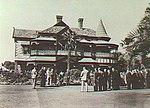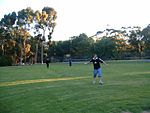Toorak Gardens, South Australia

Toorak Gardens is a leafy, mainly residential inner eastern suburb of Adelaide, South Australia, located 2 km east of the Adelaide city centre. This is one of South Australia’s most expensive suburbs. It is characterised by tree-lined streets and detached single story villas and bungalows built in the 1920s and 1930s on allotments of around 0.25 acres (0.1 hectares). The Toorak Gardens area was part of the then larger and now adjacent suburb of Rose Park. Between 1912 and 1917 it was named "Toorak" and subsequently "Toorak Gardens". Originally farmland owned by the Fergusson and Prescott families in the 19th century, it was subdivided and gained popularity in 1920s. First Creek, part of the Torrens catchment, runs through the north-east corner of the suburb. Toorak Gardens is in the local government area of the City of Burnside, and is bounded to the north by Kensington Road, to the east by Portrush Road, to the south by Greenhill Road and to the west by Prescott Terrace and Warwick Avenue.It contains the Burnside War Memorial Hospital; converted from a grand mansion in 1949, it remains Burnside's only local community hospital.
Excerpt from the Wikipedia article Toorak Gardens, South Australia (License: CC BY-SA 3.0, Authors, Images).Toorak Gardens, South Australia
Cudmore Avenue, Adelaide Toorak Gardens
Geographical coordinates (GPS) Address Nearby Places Show on map
Geographical coordinates (GPS)
| Latitude | Longitude |
|---|---|
| N -34.933 ° | E 138.638 ° |
Address
Stop 6 Grant Avenue - South side
Cudmore Avenue
5065 Adelaide, Toorak Gardens
South Australia, Australia
Open on Google Maps





